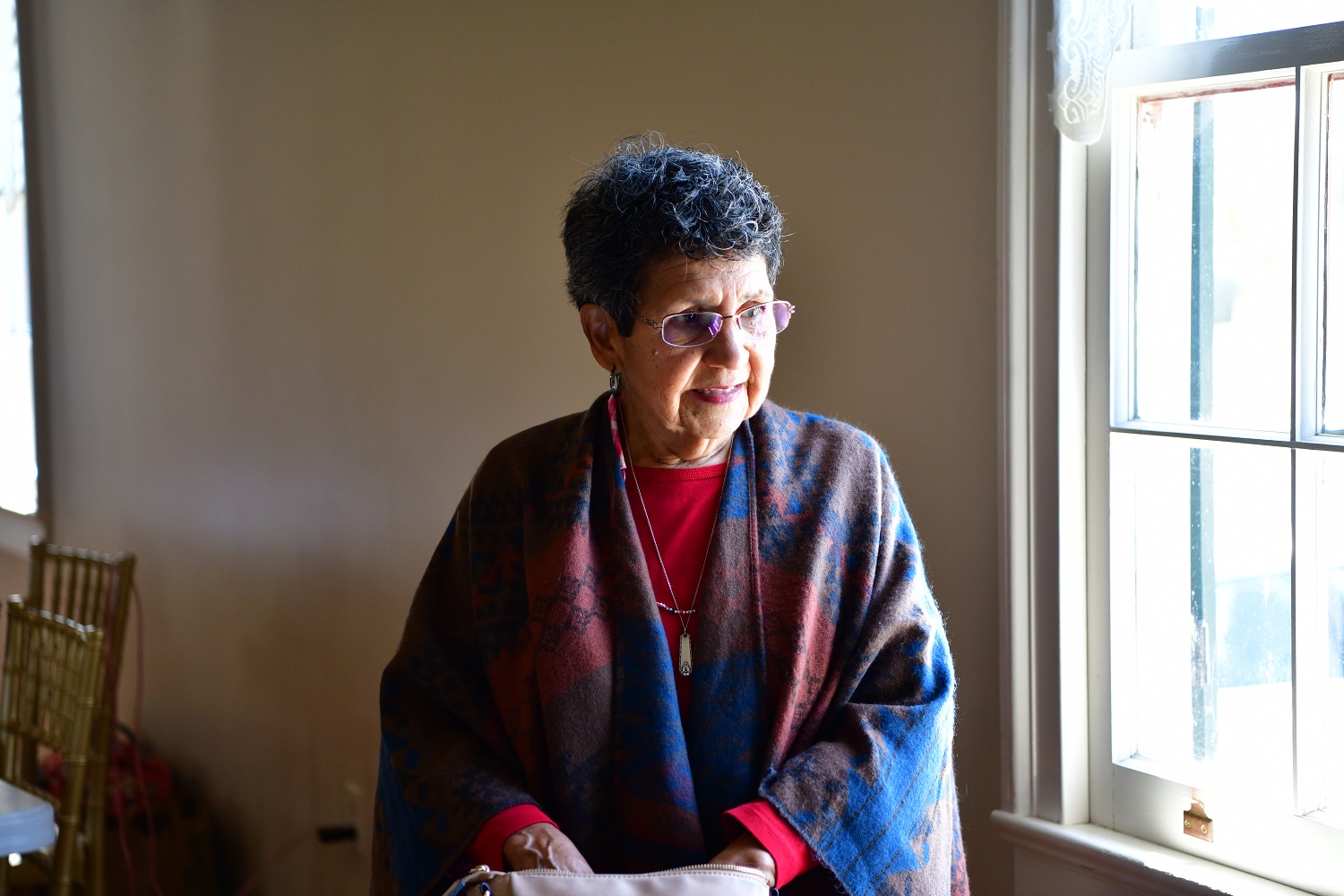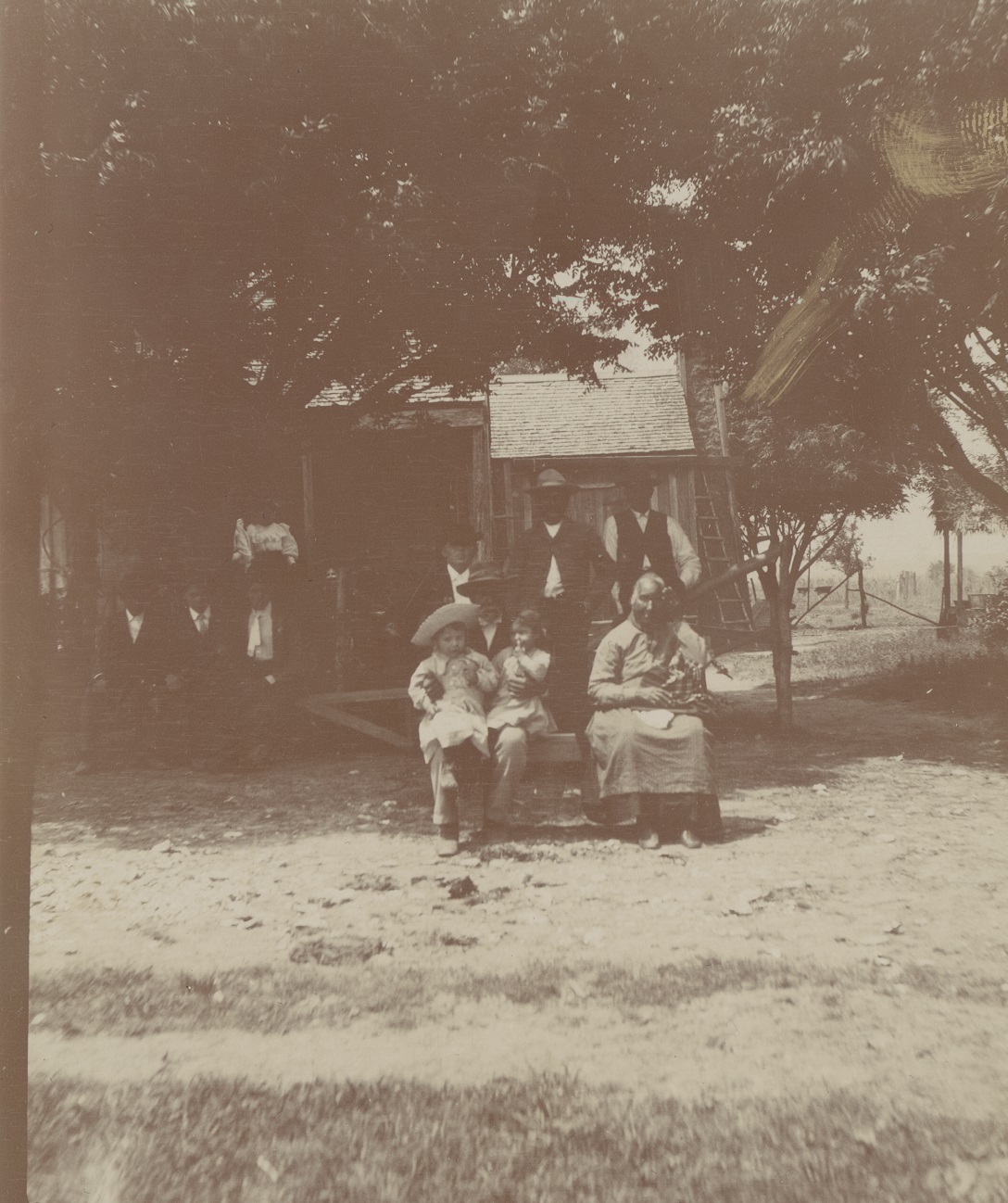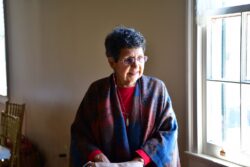Four Women and Their Languages
Lessons from the Houma Language Project
Published: November 29, 2022
Last Updated: March 22, 2023

Photo by Tammy Greer
Corine Paulk at the 2022 Tasso Time, where the Houma Language Project presented her with a written copy of her oral history collected throughout the pandemic.
Back in 2013, Colleen Billiot and I began the Houma Language Project to apply our graduate studies in conflict resolution and art, culture, and media toward Louisiana and our communities. Our group project asks the question “What were the Houma speaking pre-European contact?” and addresses it by facilitating cultural participation through language revitalization using digital engagement. The ongoing adventure has taught us much about Muskogean linguistics, but also about language shift, cultural contact, and intergenerational communication.
I want to introduce you to four women I met this year through the Houma Language Project, whose stories reflect how language use has been shaped over time within the Gulf South Indigenous community.
The Unknown Woman
The Houma Language Project is a team of tribal members and linguists who volunteer from across four US time zones. To help us stay organized, we have built a shared online library to document cultural and linguistic information on the Houma. This summer I searched through the journals in this online library to find the earliest written account of any Houma woman.
In 1701 Jesuit missionary Jacques Gravier passed through what he referred to as the “Oumas” village on the way to visit the Tunica and offered a description of a woman there.
“The old man who keeps up the fire which he called to us ‘Lou:ak’ or ‘Loughe’ (sacred fire), showed us the bones of the woman chief who died last year. This woman had rendered herself so important by the blows she had struck against the enemy, having led several war parties in person, that she was regarded as an Amazon and as the mistress of the whole village, and more honor was paid to her than to the great chief. She had the first place in all councils, and when she walked she was always preceded by four young men who sang and danced the calumet to her. She was dressed as an Amazon, painted her face and had her hair dressed like the men,” writes Gravier.
We do not know her name. French and English explorers of this time were usually male and rarely crossed the gender line to document introductions to women. These conversations, and thus the linguistic record, do not reflect the richness of female language contributions.
We do know she was important to the community. The old man speaks of her death as a fresh loss even a year later. Her bones are in a sacred fire, and the fire keeper tells her story to the missionary, both of which point to her stature. People listened to her—sometimes over other leaders in the community.
No record exists of what languages she spoke. We do know that multilingualism was common in North American cultures. Pierre Le Moyne d’Iberville, one of the founders of the French colony in Louisiana, writes in his journal that it was common for village residents to converse fluently in two or three North American languages. Along with Houma and the regional trade language Mobilian, the Unknown Woman most likely knew some Chickasaw and Natchez, as these were powerful regional languages.
That’s all we have from the trail journals. These written accounts are all secondhand observations by European scribes, as Southeastern Indigenous cultures did not use written inscription for language before European contact.
Felicité Billiot
This spring, I came across a photo of a woman, taken by John Swanton, an anthropologist, folklorist, linguist, and Smithsonian employee in the swashbuckling era of the Bureau of American Ethnology (1879–1968). Swanton traveled around the United States developing sketches of Indigenous languages and cultures, and he visited South Louisiana in 1907. One of the many photos from his trip is of an older woman in a light-colored dress sitting on a yard bench with family members.

Group seated in front of house, Terre Bonne [sic] Parish, LA. Felicité is at front right. National Anthropological Archives, Smithsonian Institution
If it is Felicité in the photo, she would be around seventy years old in 1907. Her mother would have been pregnant when US Secretary of War John C. Calhoun established the Bureau of Indian Affairs in 1824. Felicité would have been learning to talk around the time that US soldiers forced Indigenous people off their lands onto less valuable locations through the genocidal Trail of Tears made possible by the Indian Removal Act of 1830.
Based on her name, Felicité’s mother tongue may have been French. It’s noteworthy that she has a French name rather than a Houma one. The tenuous cultural environment, in which Indigenous lives were devalued and communities systematically destroyed, could have affected the Billiot women’s language choices as they raised their children. Mothers as primary caregivers are a strong force in child language acquisition. They may have chosen to censure their language when raising their children. This language training can distance a child from the cultural community but could also increase the child’s survival opportunities.
Corine Paulk
“Hello, my girls!” a cheerful voice called over the laptop. Corine Paulk is a Houma elder with permanent smile lines under her large round glasses. Every month of the COVID-19 pandemic, the Houma Language Project oral history team gathered with Corine over Zoom to record her story.
Corine grew up speaking only French at home in Dulac. She learned English in full immersion at Vashti boarding high school in Thomasville, Georgia, which she attended because of Louisiana laws limiting educational opportunities for Native Americans. Corine said that she generally enjoyed school and comments that it was difficult to be thrown into the all-English environment alone at a young age.
The brutality of school language assimilation can be traumatic. There are countless tales of school children being punished with soap in the mouth, beatings, and public shaming for speaking their mother tongues.
A common coping mechanism for people who have been through school-based language assimilation is to “forget” the language. Tahltan educator David Rattray articulates how this impacts future language generations in James McKenzie’s 2022 article “Addressing Historical Trauma and Healing in Indigenous Language Cultivation and Revitalization,” published in the Annual Review of Applied Linguistics. “I have seen this surface as anger toward older generations for not having passed the language on,” Rattray writes. “I still remember the voice cracking, tears, and frustration accompanying one of our learners’ emotions, as they recounted not being raised in our language. Further, learners can experience criticism or judgment for their (perceived lack of) language abilities, or discouragement from learning the language.”
The extent to which individuals have accepted, grieved, and healed around these experiences of language suppression can be a key factor in the success of language revitalization. Part of the Houma Language Project’s work is to facilitate truth and reconciliation that supports and celebrates the practice of public and interpersonal language use, and honors the community memory of struggle and language suppression.
In our interviews, Corine describes how she became one of the first employees in the Terrebonne Parish Indian Education Program, established a young ladies’ after-school group in Dulac, and collected decades of newspaper clipping of successful Houma citizens. She hopes one day that her legacy will help people be proud of their culture and history. Corine is still thrilled to speak French with anyone she meets who appreciates the language and her spirited care of it.
Brittany Verdin Jimenez
Despite talking weekly online, many in the Houma Language Project have never met in person. I worked with Brittany Verdin Jimenez for four years before we hugged for the first time in Missoula, Montana, at a language training workshop. She is shorter than I imagined. She mentioned that she found me taller than she imagined. As we talked among our luggage in a college dorm lobby, we become more familiar.
Brittany is a quick-witted and charismatic Texan, and mother of two who grew up in Marrero with English as her first language. She is one of the learners and developers of Uma’, the recovered Indigenous language of the Houma that our project has developed over the last nine years.
We squeeze into the elevator with the rest of our team. We have come to this conference to design ways to teach Uma’ outside of the classroom context. Brittany and the other Houma Language Project volunteers challenge the chokehold that school-based language education has on language revitalization efforts. Justyna Olko and Julia Sallabank write bluntly about this view in their 2021 edited volume Revitalizing Endangered Languages: “People often assume that because children seem to learn languages easily, and because schools are effective at killing minority languages, they need to get their languages taught in schools.”
Brittany has created the first online immersion lesson in Uma, publicly available on YouTube along with other open-source learning materials. Each semester, she and fellow project volunteer Ben Wood mentor Uma’ language learners through the Houma Youth Internship Program, a grant that offers paid internships for those interested in learning Uma’, Houma French, or archive research skills.
Brittany knows she cannot singlehandedly restore the multiplicity of Houma languages, but she is committed to a long-range vision, and to leaving something behind that others might be interested in picking up in their own way. She wants to find a linguistics undergraduate program that would let her study virtually, support her family, and continue the mission of exuding language and cultural growth through art, digital media, crafts, gardening, and storytelling.
Indigenous languages and Indigenous women in Louisiana are underrepresented in the historical record and the stories we share; these four impressions cannot capture the range and richness of this community’s past and present and their visions of the future. In 2019, UNESCO named 2022–2032 the Indigenous Language Decade, a time to preserve, revitalize, and support indigenous languages worldwide. We hope you have more chances to listen to Indigenous languages, benefiting from the efforts of the Koasati Language Project, the Tunica–Biloxi Language and Culture Revitalization Program, the Chitimacha language department, and the many other language activists and linguaphiles who labor to create art, oral histories, and other language celebrations.
Hali Dardar is a member of the United Houma Nation and co-founder of the Houma Language Project. She holds a BA in print journalism from Louisiana State University, an MA in arts, culture, and media from Rijksuniversiteit, and currently works as the Language Vitality Project Coordinator at the Smithsonian Center for Folklife and Cultural Heritage.
